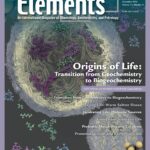
Geomicrobiology And Microbial Geochemistry, December 2015, Vol. 11, No. 6
June 28, 2024
Origins Of Life: Transition From Geochemistry To Biogeochemistry, December 2016, Vol. 12, No. 6
June 28, 2024Cosmic Dust, June 2016, Vol. 12, No. 3
$20.00
Cosmic dust is submillimeter debris shed by comets, asteroids, moons, and planets. In the Solar System, this dust scatters sunlight (the zodiacal light), and it is detected around other stars by its infrared emission.
Cosmic Dust
June 2016, Vol. 12, No. 3
Cosmic dust is submillimeter debris shed by comets, asteroids, moons, and planets. In the Solar System, this dust scatters sunlight (the zodiacal light), and it is detected around other stars by its infrared emission. Cosmic dust enters Earth’s atmosphere at high speeds and at a rate of 100 tons a day. These small particles are the largest source of extraterrestrial material accreting on the present-day Earth and include interplanetary dust particles and micrometeorites. Although atmospheric entry heating and terrestrial weathering have modified many, some particles are pristine primitive extraterrestrial materials that contain high abundances of isotopically anomalous presolar grains and primitive carbon compounds that have not been altered since their formation. Cosmic dust analysis provides invaluable information on initial planetary building materials.
Why You’ll Love Elements Magazine:
- Expert Contributors: Articles written by renowned researchers in the field of geoscience.
- Engaging Content: Join a community of readers who are passionate about Elements.
- Exceptional Quality: Each issue is printed on high-quality paper with stunning visuals and detailed illustrations that bring complex scientific concepts to life.
Order your copy of the June 2016 issue of Elements magazine today and discover cosmic dust.
Related products
-
Large Igneous Provinces: Origin And Environmental Consequences, December 2005, Vol. 1, No. 5
$20.00Large igneous provinces record major outpourings of igneous rocks, both on the continents and in ocean basins. Their origin is still vigorously disputed, with models invoking mantle plumes, thermal effects of the lithosphere, and meteorite impacts.
-
Arsenic, April 2006, Vol. 2, No. 2
$20.00Arsenic is an element known throughout history as a classic poison. Currently, very small but highly significant concentrations of this element in drinking water supplies are causing massive health problems to many millions of people in some of the world’s poorest nations, and more localised sources related to mining and processing are also a concern.
-
Diamonds, March 2005, Vol. 1, No. 2
$20.00Diamond, the fascinating ultrahard mineral, is the focus of considerable interest and scientific research. Recent advances particularly relevant to geoscientists include: diamond as a recorder of Earth processes from the perspective of inclusions, chemistry, and conditions of formation; synthesis for research applications and processing to modify color and physical properties, important to diamond gems and anvils; the implications of nanodiamonds from meteorites.




